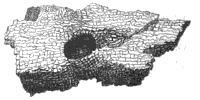 | ||
Cavall 7
Cavall (Middle Welsh: cauall RBH & WBR; modernized: Cafall; pronunciation: /kaˈvaɬ/; Latin: Cabal, var. Caball ())) is the name of Arthur's dog, used in the hunt for the great boar, Twrch Trwyth (Latin: Troynt, Troit).
Contents
- Cavall 7
- O ball ro cavall
- Historia Brittonum
- Culhwch ac Olwen
- Ysgithyrwyn Chief Boar
- List of dogs
- Cavall the horse
- Etymology
- References
Cavall was Arthur's "favourite dog", and during a stag hunt, he was customarily the last dog to be let loose to chase after the game (Gereint Son of Erbin).
O ball ro cavall
Historia Brittonum
Legend in antiquity has it that Cabal left his permanent footprint in the rock while pursuing the boar Troynt. The lore is preserved in the Wonders of Britain (De Mirabilibus Britanniae or Mirabilia in shorthand) appended to Historia Brittonum (9th century). The wonderous nature of this cairn of stones was that even if someone removed that footprinted stone to another spot, it would be back at its original heap the next day.
The Latin account has the mark of age, since it refers to Arthur merely as warrior and not king. The full quote in translation is given in the Twrch Trwyth (or wikisource), but Lady Guest's notes might best be consulted, since it provides both the Latin text and translation, as well as commentary on the Carn Cavall as well (Schreiber 1849, pp. 358–360).
Culhwch ac Olwen
Unlike the simple primitive lore, the late Welsh romance Culhwch and Olwen weaves a much more intricate tale, naming many dogs besides Cavall in the hunting party, and the quarry is no longer just the boar Twrch Trwyth itself, its seven offspring (with names), and yet another boar named Yskithyrwyn besides.
Ysgithyrwyn Chief-Boar
Yskithyrwyn Penbaedd (or Ysgithyrwyn Chief Boar) was yet another boar to be hunted by Arthur's band; its tusk, which needed to be extracted while still alive, being another of the "impossible tasks" (anoeth; pl. anoethiau) prescribed by Ysbaddaden Chief-Giant. This tusk was the tool necessary for shaving the giant to groom him up, him being the father of the bride Olwen.
In Culhwch and Olwen, Arthur's dog Cavall is specifically credited with the slaying of Yskithyrwin (or at least with cornering the beast to its doom). Caw of Prydain who rides Arthur's mare Llamrei cleaves Yskithyrwyn's head with a hatchet.
Afterwards, "Bedwyr leading Cavall, Arthur's own dog", joins the other hunters and dogs to pursue the great boar Twrch Trwyth and its piglings. But the specific role played by Cavall is not told.
List of dogs
The other hounds, which either belonged to Arthur's retinue or were recruited elsewhere, include:
Cavall the horse
It should be pointed out, in reference to the above list of dogs, that Glas, Glesig, and Gleisad are referred to as dogs, and Call, Cuall, and Cafall as horses, and so on down the line, in the list of belongings of sons of Cleddyf, or, at least they are nowadays in modern translations (such as Gwyn & Thomas Jones', 1949 and Jeffrey Gantz's, 1976). However, in the first English translation by Lady Guest, Glas, etc. were construed as sword names and Call, Cuall, Cavall as dogs, respectively.
Etymology
Ifor Williams has made a study of occurrences of Cafall in old Welsh poetry.
Many scholars seem to hit upon the similarity of the dog's name to the Latin word for "horse". In an article from 1936, R. J. Thomas said "that the name Cabal is from Latin caballus 'horse', which he considers a quite natural metaphor since the dog was strong and swift, and he compares the horse of Conall Cernach which had a dog's head".
Bromwich further remarks, "Since carn means both 'hoof' and 'cairn' it seems more probable that Cabal/Cafall originally designated Arthur horse.. rather than his hound."
